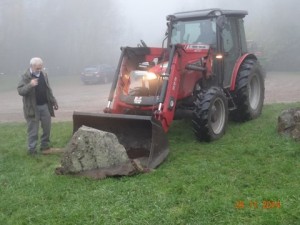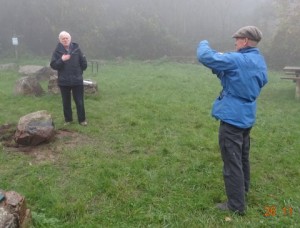Significant boulder finds a new home in Tank Quarry!
I first noticed the boulder at the bottom of Moorlands Road in Malvern about a year ago (Summer 2013). I realised that it would make a significant addition to the Geology Trail at Tank Quarry but was not sure who would transport it. In October 2014 I showed the boulder to John Payne (from the EHT) who suggested that Dick Bryant (from the EHT) and David Armitage (Assistant Manager, MHAONB) would be worth contacting – and they were! The boulder was duly transported on the morning of Wednesday 26 November 2014, by staff from the Malvern Hills Conservators. David Armitage has agreed to spend some money on up-dating the explanation boards at Tank.
Granite dyke
This boulder shows a very good example of a dyke. A medium-grained granite has invaded an older, dark –coloured, coarse-grained amphibolite which consists mainly of the mineral amphibole. The amphibole separated at an early stage in the cooling of the magma and eventually crystallised at depth in the earth’s crust to form solid rock. At a much later stage a magma rich in silica has invaded the older rock, forcing its way along zones of weakness. You can see minor off-shoots of the main dyke cutting across the amphibolite. Also you can see where blocks of amphibolite have been broken off and form inclusions (xenoliths) within the granite.
Granite dyke
This boulder shows a very good example of a dyke. A medium-grained granite has invaded an older, dark –coloured, coarse-grained amphibolite which consists mainly of the mineral amphibole. The amphibole separated at an early stage in the cooling of the magma and eventually crystallised at depth in the earth’s crust to form solid rock. At a much later stage a magma rich in silica has invaded the older rock, forcing its way along zones of weakness. You can see minor off-shoots of the main dyke cutting across the amphibolite. Also you can see where blocks of amphibolite have been broken off and form inclusions (xenoliths) within the granite.





